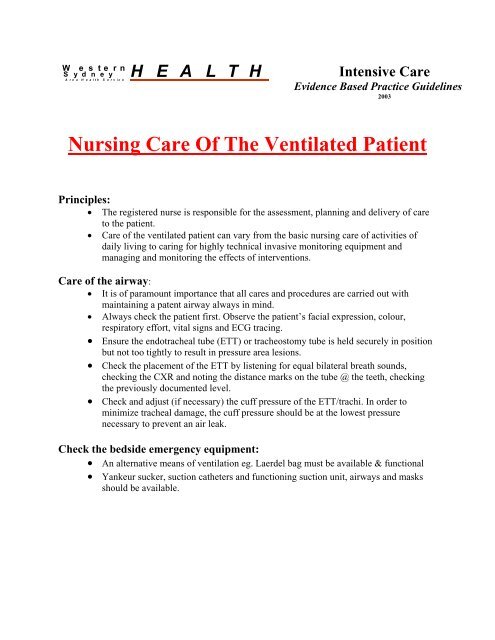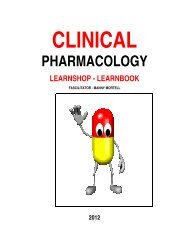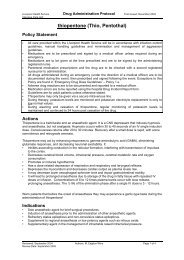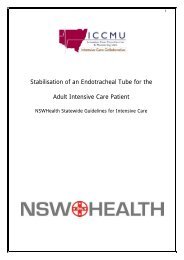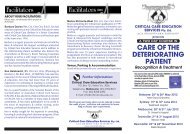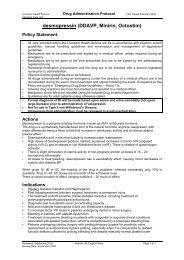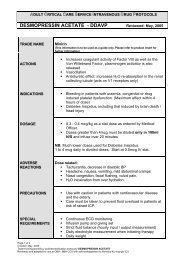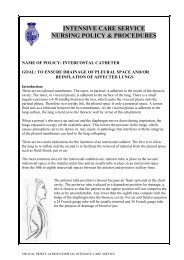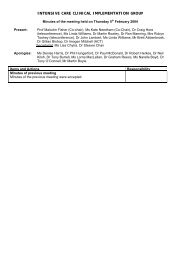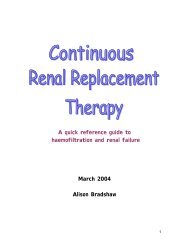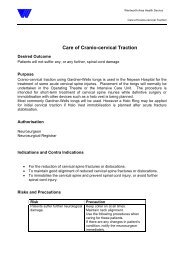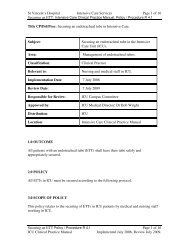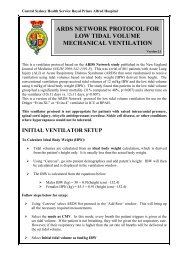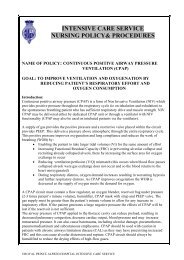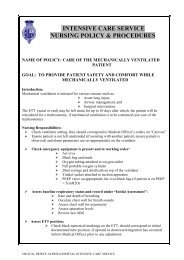Nursing care of the ventilated patient (SWAHS) - Intensive
Nursing care of the ventilated patient (SWAHS) - Intensive
Nursing care of the ventilated patient (SWAHS) - Intensive
Create successful ePaper yourself
Turn your PDF publications into a flip-book with our unique Google optimized e-Paper software.
A re a H e a lth S e rv ic e<br />
H E A L T H<br />
W e s t e r n<br />
S y d n e y <strong>Intensive</strong> Care<br />
Evidence Based Practice Guidelines<br />
2003<br />
<strong>Nursing</strong> Care Of The Ventilated Patient<br />
Principles:<br />
• The registered nurse is responsible for <strong>the</strong> assessment, planning and delivery <strong>of</strong> <strong>care</strong><br />
to <strong>the</strong> <strong>patient</strong>.<br />
• Care <strong>of</strong> <strong>the</strong> <strong>ventilated</strong> <strong>patient</strong> can vary from <strong>the</strong> basic nursing <strong>care</strong> <strong>of</strong> activities <strong>of</strong><br />
daily living to caring for highly technical invasive monitoring equipment and<br />
managing and monitoring <strong>the</strong> effects <strong>of</strong> interventions.<br />
Care <strong>of</strong> <strong>the</strong> airway:<br />
• It is <strong>of</strong> paramount importance that all <strong>care</strong>s and procedures are carried out with<br />
maintaining a patent airway always in mind.<br />
• Always check <strong>the</strong> <strong>patient</strong> first. Observe <strong>the</strong> <strong>patient</strong>’s facial expression, colour,<br />
respiratory effort, vital signs and ECG tracing.<br />
• Ensure <strong>the</strong> endotracheal tube (ETT) or tracheostomy tube is held securely in position<br />
but not too tightly to result in pressure area lesions.<br />
• Check <strong>the</strong> placement <strong>of</strong> <strong>the</strong> ETT by listening for equal bilateral breath sounds,<br />
checking <strong>the</strong> CXR and noting <strong>the</strong> distance marks on <strong>the</strong> tube @ <strong>the</strong> teeth, checking<br />
<strong>the</strong> previously documented level.<br />
• Check and adjust (if necessary) <strong>the</strong> cuff pressure <strong>of</strong> <strong>the</strong> ETT/trachi. In order to<br />
minimize tracheal damage, <strong>the</strong> cuff pressure should be at <strong>the</strong> lowest pressure<br />
necessary to prevent an air leak.<br />
Check <strong>the</strong> bedside emergency equipment:<br />
• An alternative means <strong>of</strong> ventilation eg. Laerdel bag must be available & functional<br />
• Yankeur sucker, suction ca<strong>the</strong>ters and functioning suction unit, airways and masks<br />
should be available.
W e s t e r n<br />
S y d n e y<br />
A re a H e a lth S e rv ic e<br />
H E A L T H<br />
<strong>Nursing</strong> Care Of The Ventilated Patient<br />
<strong>Intensive</strong> Care<br />
Evidence Based Practice Guidelines<br />
2003<br />
Ventilation:<br />
• Ensure <strong>the</strong> ventilation tubing is not kinked and that it is adequately supported so as<br />
not drag on <strong>the</strong> ETT/trachi. Take <strong>care</strong> <strong>of</strong> <strong>the</strong> tube while turning or moving <strong>the</strong> <strong>patient</strong>.<br />
• Check <strong>the</strong> ventilator and document <strong>the</strong> settings. Look at <strong>the</strong> alarm parameters and<br />
reset if necessary.<br />
• Ensure <strong>the</strong> ventilator and <strong>the</strong> cardiac monitor are plugged into emergency power<br />
supply in case <strong>of</strong> power failure.<br />
• Ensure that you have enough room to access <strong>the</strong> head <strong>of</strong> <strong>the</strong> bed in an emergency.<br />
• Check <strong>the</strong> type <strong>of</strong> humidification, and when <strong>the</strong> filters and ventilation tubing were last<br />
changed.<br />
• HME filters and end expiratory filters are changed routinely (and marked with <strong>the</strong><br />
date and time) every 24 hours or more frequently if <strong>the</strong>re is condensation visible.<br />
• Ventilator circuits are changed weekly.<br />
• Indications for an actively humidified circuit (Westmead ICU):<br />
� minute volume greater than 10 litres<br />
� chest trauma with pulmonary contusion<br />
� airway burns<br />
� severe asthma<br />
� hypo<strong>the</strong>rmia (
W e s t e r n<br />
S y d n e y<br />
A re a H e a lth S e rv ic e<br />
H E A L T H<br />
<strong>Nursing</strong> Care Of The Ventilated Patient<br />
<strong>Intensive</strong> Care<br />
Evidence Based Practice Guidelines<br />
2003<br />
• Closed suction ca<strong>the</strong>ters should be rinsed post suctioning to remove mucous and to<br />
reduce <strong>the</strong> likelihood <strong>of</strong> bacterial growth.<br />
• Tracheal suctioning should be attended 2 - 3 hourly, more <strong>of</strong>ten if necessary (See<br />
Suctioning an Artificial Airway Guideline).<br />
• Suction <strong>the</strong> oropharynx to remove potentially infected secretions.<br />
Monitors:<br />
• Check <strong>the</strong> level <strong>of</strong> any invasive monitoring transducers and zero <strong>the</strong>m. (Haemodynamic<br />
Monitoring Guideline).<br />
• Check <strong>the</strong> alarm parameters and reset if necessary<br />
• Document <strong>the</strong> <strong>patient</strong>’s vital signs hourly and when <strong>the</strong>re is a deviation from <strong>the</strong><br />
usual.<br />
• Check and document a manual blood pressure to assess <strong>the</strong> accuracy <strong>of</strong> <strong>the</strong> arterial<br />
trace once a shift.<br />
Oral Care:<br />
• The aim <strong>of</strong> oral <strong>care</strong> and assessment is to promote normal hygiene while preventing<br />
infection and trauma.<br />
• The presence <strong>of</strong> an ETT can cause hyper salivation in some <strong>patient</strong>s and an<br />
uncomfortably dry mouth in o<strong>the</strong>rs.<br />
• A s<strong>of</strong>t toothbrush can be used for oral hygiene and a small amount <strong>of</strong> toothpaste can<br />
help <strong>the</strong> cleansing action. Using large amounts <strong>of</strong> toothpaste may leave a residual<br />
coating and produce a burning sensation if it is not rinsed away properly.<br />
• Properly diluted sodium bicarbonate may be used to remove resistant coating on <strong>the</strong><br />
tongue, debris or tenacious secretions but again overuse may cause superficial burns.<br />
• The lips should be kept moisturized to stop <strong>the</strong>m becoming sore and cracked.<br />
• 2 nd hourly oral <strong>care</strong> is recommended, using water, not saline, and oral swabs and<br />
thorough suctioning <strong>of</strong> oral secretions, a toothbrush & paste should be used at least<br />
once a shift and more <strong>of</strong>ten if indicated.
W e s t e r n<br />
S y d n e y<br />
A re a H e a lth S e rv ic e<br />
H E A L T H<br />
<strong>Nursing</strong> Care Of The Ventilated Patient<br />
<strong>Intensive</strong> Care<br />
Evidence Based Practice Guidelines<br />
2003<br />
Eye Care:<br />
• The unconscious, sedated or paralyzed <strong>patient</strong> is at risk <strong>of</strong> developing eye problems<br />
ranging from mild conjunctivitis to serious corneal injury and ulceration. Permanent<br />
eye damage may result from ulceration, perforation, vascularization and scarring <strong>of</strong><br />
<strong>the</strong> cornea.<br />
• Sedation and muscle relaxants can lead to inadequate closure <strong>of</strong> <strong>the</strong> eye, lack <strong>of</strong><br />
random eye movements and a loss <strong>of</strong> <strong>the</strong> blink reflex, all <strong>of</strong> which can lead to<br />
complications.<br />
• Fluid imbalances and increased permeability can promote conjunctival oedema.<br />
• Constrictive securing tapes can compromise venous return from <strong>the</strong> head leading to<br />
venous congestion and maybe an increase in interocular pressure and <strong>the</strong>refore an<br />
increase in conjunctival oedema.<br />
• 2 nd hourly eye <strong>care</strong> using saline soaked gauze to clean <strong>the</strong> eye and <strong>the</strong> application <strong>of</strong><br />
lactrilube regularly in <strong>the</strong> <strong>ventilated</strong> <strong>patient</strong> is recommended to help reduce <strong>the</strong> risk <strong>of</strong><br />
complications.<br />
G.I.T:<br />
• Intubated <strong>patient</strong>s must have a nasogastric tube for gastric decompression or<br />
nutritional support.<br />
• The presence <strong>of</strong> bowel sounds and <strong>the</strong> turgor <strong>of</strong> <strong>the</strong> abdomen should be assessed<br />
during <strong>the</strong> initial assessment.<br />
• Nutrition and hydration are essential to build respiratory muscle strength necessary<br />
when a <strong>patient</strong> is being weaned from a ventilator. Patients who have inadequate<br />
nutritional stores are prone to infection, fluid and electrolyte imbalance, intestinal<br />
fluid retention, weight loss, pressure areas and poor wound healing.<br />
• Patients with a functioning GI tract should be fed enterally. TPN may be used if <strong>the</strong>re<br />
are contraindications to enteral feeding.<br />
• The enterally fed <strong>patient</strong> should be monitored for diarrhoea, dehydration, fluid<br />
overload, constipation or abdominal cramping. These observations can be a guide in<br />
determining <strong>the</strong> strength and rate <strong>of</strong> increase <strong>of</strong> <strong>the</strong> feeds.<br />
• NG tubes should be flushed with 20-30 mls <strong>of</strong> water before and after administering<br />
medications.<br />
• Fine bore tubes can not be aspirated but should be flushed 4 hourly with water.
W e s t e r n<br />
S y d n e y<br />
A re a H e a lth S e rv ic e<br />
H E A L T H<br />
<strong>Nursing</strong> Care Of The Ventilated Patient<br />
<strong>Intensive</strong> Care<br />
Evidence Based Practice Guidelines<br />
2003<br />
• If <strong>the</strong> <strong>patient</strong> is not being fed enterally <strong>the</strong> NG tube should be on free drainage and<br />
aspirated and flushed 6 hourly with water.<br />
• If <strong>the</strong> enterally fed <strong>patient</strong> has large aspirates (>200mls or > 4 hours feed) consult<br />
with medical staff regarding reducing <strong>the</strong> feed and/or discarding <strong>the</strong> aspirate.<br />
O<strong>the</strong>rwise <strong>the</strong> aspirate is generally returned if less that 200 mls or < 4 hours feed.<br />
• Elevating <strong>the</strong> head <strong>of</strong> <strong>the</strong> bed to 30 - 45 degrees (unless contraindicated) is effective<br />
in reducing <strong>the</strong> risk <strong>of</strong> aspiration.<br />
• Elimination should be recorded and aperients given if necessary.<br />
Genital/Urinary Tract:<br />
• IDCs predisposes urinary tract infections.<br />
• Routine urinalysis should be twice a day<br />
• Regular penil/perineum ca<strong>the</strong>ter <strong>care</strong> should be done.<br />
• The ca<strong>the</strong>ter should be secured to <strong>the</strong> leg <strong>care</strong>fully and repositioned as necessary to<br />
prevent pressure areas.<br />
• Hourly urine monitoring is carried out and medical staff informed <strong>of</strong> abnormally high<br />
or low measurements. Aim for a urine output <strong>of</strong> 0.5ml/kg.<br />
Repositioning And Pressure Area Care:<br />
• Attending to <strong>the</strong> <strong>patient</strong>’s hygiene protects <strong>the</strong> skin and ensures dignity and comfort<br />
• Ventilated <strong>patient</strong>s are at a higher risk <strong>of</strong> developing nosocomial infections and<br />
pressure areas due to <strong>the</strong>ir immobility, <strong>the</strong>ir underlying disease process and <strong>the</strong><br />
presence <strong>of</strong> invasive monitoring lines and equipment.<br />
• Repositioning <strong>the</strong> <strong>patient</strong> regularly has a number <strong>of</strong> positive effects:<br />
� routine turning and positioning assists in <strong>the</strong> mobilization <strong>of</strong> secretions<br />
� prevents <strong>the</strong> development <strong>of</strong> pressure areas, joint stiffness and deformities<br />
� improves oxygenation and can encourage weaning from <strong>the</strong> ventilator.<br />
� provides a different view on <strong>the</strong> environment for <strong>the</strong> <strong>patient</strong><br />
� <strong>the</strong> <strong>patient</strong> should be repositioned 2 nd hourly if possible, taking <strong>care</strong> to<br />
position <strong>the</strong> limbs in proper alignment and supporting <strong>the</strong>m to prevent<br />
dependant oedema.<br />
• If <strong>the</strong> <strong>patient</strong> has leg splints on <strong>the</strong>y should be on for 2 hours and <strong>of</strong>f for 2 hours.<br />
They should not be bandaged and <strong>the</strong> skin integrity should be checked with each turn.<br />
•
W e s t e r n<br />
S y d n e y<br />
A re a H e a lth S e rv ic e<br />
H E A L T H<br />
<strong>Nursing</strong> Care Of The Ventilated Patient<br />
<strong>Intensive</strong> Care<br />
Evidence Based Practice Guidelines<br />
2003<br />
• The ETT and o<strong>the</strong>r lines should be safeguarded during turning and <strong>care</strong> should be<br />
taken to ensure that <strong>the</strong>re are no lines or o<strong>the</strong>r equipment under <strong>the</strong> <strong>patient</strong> turned.<br />
• The skin should be kept dry and should be inspected with each change <strong>of</strong> position,<br />
including under restraints. (Refer to Restraints Guideline)<br />
• The head <strong>of</strong> <strong>the</strong> bed should be elevated if <strong>the</strong> <strong>patient</strong>’s condition allows to help<br />
prevent aspiration and improve oxygenation.<br />
• If <strong>the</strong> <strong>patient</strong> has any signs <strong>of</strong> developing pressure areas he/she should be nursed on<br />
an air mattress. (Refer to Pressure Area Care Guideline).<br />
• The ETT should be repositioned at alternate sides <strong>of</strong> <strong>the</strong> mouth to prevent pressure<br />
areas developing.<br />
• The NG tube should be secured in such a way as to minimize pressure on <strong>the</strong> nares<br />
and changed at least daily.<br />
• If <strong>the</strong> <strong>patient</strong> has a hard collar it should be changed to an Aspen collar as soon as<br />
possible and <strong>the</strong> back <strong>of</strong> <strong>the</strong> head and neck checked once a shift for <strong>the</strong> presence <strong>of</strong><br />
pressure areas.<br />
References:<br />
1. Anonymous. (2002) ‘Eye <strong>care</strong> for intensive <strong>care</strong> <strong>patient</strong>s‘, Best Practice Vol 6 (1)<br />
ISSN 1329-1874.<br />
2. Ashurst,S. (1997) ‘<strong>Nursing</strong> <strong>care</strong> <strong>of</strong> <strong>the</strong> mechanically <strong>ventilated</strong> <strong>patient</strong> in ITU: 1,<br />
British Journal <strong>of</strong> <strong>Nursing</strong> Vol 6 (9) Nov, 447-454.<br />
3. Blackwood, B. (1998) ‘The practice and perception <strong>of</strong> intensive <strong>care</strong> staff using <strong>the</strong> closed suction system’,<br />
Journal <strong>of</strong> Advanced <strong>Nursing</strong> Vol 28 (5) Nov,1020-1029.<br />
4. Greifzu, S. (2002) ‘Caring for <strong>the</strong> chronically critically ill’, RN Vol 65 (7) July, 42-44, 46, 48-49.<br />
5. Hickson,S, Sole,M.L, King,T. (98) ‘<strong>Nursing</strong> Strategies to prevent Ventilator-Associated Pneumonia, AACN<br />
Clinical Issues Vol 9 (1) Feb, 76-90.<br />
6. Schwenker,D, Ferrin,M, Gift,A. (1998) ‘A survey <strong>of</strong> Endotracheal suctioning with instillation <strong>of</strong> NaCl’, American<br />
Journal <strong>of</strong> Critical Care Vol 7 (4) 256.<br />
7.Stamm,A.M. (1998) ‘Ventilator- associated pneumonia and frequency <strong>of</strong> circuit changes’, American Journal <strong>of</strong><br />
Infection Control Vol 26 (1) Feb, 71-73.<br />
8. Tan,I.K.S, Oh,T.E.(1997) <strong>Intensive</strong> Care Manual, 4 th ed, p.246, Bath, Butterworth & Heinemann.<br />
Auburn Hospital and Community Health Services • Blacktown Mt Druitt Health Service Cumberland Hospital •<br />
Lottie Stewart Hospital • St Joseph’s Hospital • Westmead Hospital and Community health Services • Parramatta<br />
Linen Services


